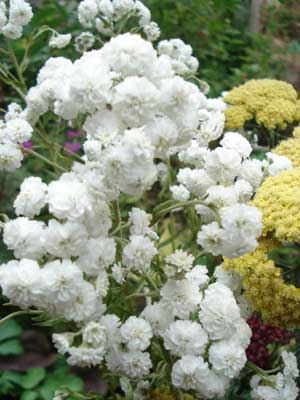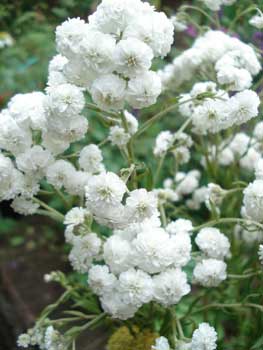
'Angel's Breath'
Double Yarrow
"With what doubting eyes, oh sparrow,
Thou regardest me,
Underneath yon spray of yarrow,
Dipping cautiously."
-Archibald Lampman
(1861-1899)
The double-white pompom flowers of Achillea ptarmica 'Angel's Breath' are very small individually but occur in great numbers for a showy blossom. These are so different from the flat-head blooms of common yarrow (A. millefolium) that it's hard to recognize it as of the same genus.(1861-1899)
 This Eurasian wildflower shares with A. millefolium a hardiness in well-drained soils in full sun, growing upright, with repeat bloom (if deadheaded) from July through much of Autumn or the first hard frost, strongly disliked by deer, & leaves with spicy scent when rubbed.
This Eurasian wildflower shares with A. millefolium a hardiness in well-drained soils in full sun, growing upright, with repeat bloom (if deadheaded) from July through much of Autumn or the first hard frost, strongly disliked by deer, & leaves with spicy scent when rubbed.It's likewise loved by butterflies & bees, & is the preferred host for a number of micro-butterflies. It is superb for cut flowers, & can be dried for dry floral arrangement. Also like common milfoil its cold-hardy to zone 4 & possibly 3. Its volatile oils have been used medicinally. It has been a traditional potherb with peppery flavor to the leaves, fresh or dried, although overuse can cause stomach distress.
It can will self-sew its seed & spread by underground runners a little willfully if it loves its conditions enough. The parent clumps may need division every three or four years. When seedlings pop up in unexpected places in spring, these can easily be removed, or allowed to develop a very few weeks & transferred to pots to give as gifts when they flower.
Shown here is the double-flowering snow-white cultivar 'Angel's Breath.' The wild form looks much more like a corymbe of miniature daisies, but there is also a double form with slightly reflexed petals around the pompom.
Though the pictorial tag that came with this one referred to its "ferny leaves," this was just parroted from descriptions of common yarrow. The leaves are not fern-like on A. ptarmica, but small toothed lances, toxic to cattle & horses. The leaves can be powdered as an insect repellant.
A. ptarmica has an array of common names. It's variously known as Bastard Pellitory, German Pellitory, European Pellitory or Wild Pellitory, because the blooms resemble those of pellitory or Spanish chamomile (Anacyclus pyrethrum) though its oils do not share the true pellitory's value as a toothache remedy.
It's also known as Fair-Maids-of-France, White Tansy, Goose-tongue, Brideflower, or Russian Daisy. Germanic nations have known it as Wilde Bertram, identifying it with a white raven, divine wisdom, & the god Odin. It's species name means "causes sneezing," inspired by its common names Sneezeweed or Sneezewort. For its round button-flowers, it's called Pearlwort or Pearl Yarrow.
Attractive & easy to grow, clip it down to within six inches of the basal leaves before it goes to seed & it will immediately develop a second flowering. Don't overwater, but don't expect it to be as drought-hardy as common yarrow.
Continue to:
'Moonshine' Yellow Milfoil